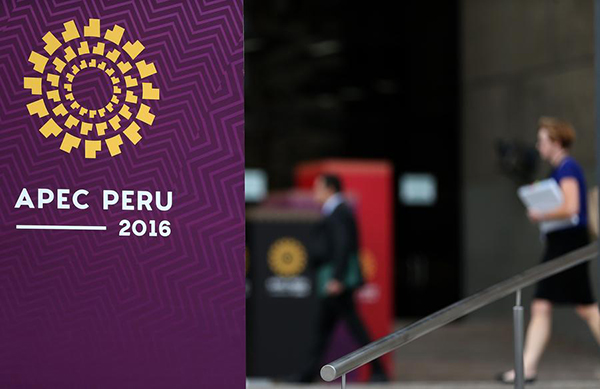Inclusive policy for a fairer Asia-Pacific
 |
|
People walk outside the International Media Center (IMC) of the 2016 APEC Economic Leaders' Week in Lima, capital of Peru, on Nov 15, 2016. [Photo/Xinhua] |
Against the backdrop of a sluggish global economy, lackluster trade growth and uncertainty in major economies, countries in the Asia-Pacific region are still likely to have a growth rate of 4.9 percent this year.
The region continues to lead in global economic growth, mainly bolstered by major economies such as China and India. However, if the remaining challenges are not adequately addressed, they could scuttle stability and undermine the efforts to meet the ambitious goals of the UN's 2030 Agenda for Sustainable Development.
The year-end update of the Economic and Social Survey for Asia and the Pacific 2016-an annual assessment by the UN Economic and Social Commission for Asia and the Pacific-pins the resilience of the region's economies on ongoing fiscal and structural reforms, but cautions that the pace of economic expansion over the past years did not help create decent jobs in a number of countries. The result is a high share of vulnerable employment and widening income inequality, which could lead to "economies of exclusion". It is telling that the population-weighted Gini coefficient in the region, based on household income estimates, increased by 11 points or 30 percent, from 37 to 48, between 1990 and 2014.
These developments should be taken seriously, because widening inequality has had a deleterious impact on countries and populations, especially the most vulnerable.
Incremental inroads have been made in structural transformation throughout the region, but they could be undermined if measures to enhance workers' skills are not put in place. Indeed, the gains derived from our collective push toward technological progress should translate into higher real wages, supported by enhanced social protection. It is troubling that more than 1 billion workers in the Asia-Pacific are in vulnerable employment, often without access to social or legal protection. Much more should and can be done to ensure greater inclusion-a move away from a growth-centric development framework toward a holistic approach that takes into account social, environmental and governance would be a step in the right direction.
The annual review is equally prudent about the region's near-term economic outlook. In particular, there are concerns over the effects of recent developments on the world's major economies, which could increase protectionism and thus reduce external demand resulting in slowing down the integration of developing countries into global and regional value chains.
While the ramifications of Brexit and current trade policy sentiments in the United States are yet to be seen, we cannot afford to ignore the warnings they send out.
The report makes a strong argument for an active role of fiscal policy in supporting domestic demand and meeting long-term development goals. One of the effective ways of addressing structural bottlenecks in the current environment of weak external demand, weak private investment, low borrowing costs and benign inflationary pressures is of course public infrastructure outlays. We have already seen some meaningful interventions by countries to improve public financial management by reforming state-owned enterprises and enhancing tax revenue, and these measures have shown to contribute to a strengthening of the fiscal position on a sustainable basis.
Notwithstanding the inherent challenges, taxes and, in particular, progressive personal income tax can be a pivotal policy tool for direct redistribution of income and wealth. As a whole, the Asia-Pacific has one of the world's lowest tax revenue levels, just 17.6 percent of GDP. Improved healthcare, education and other social goods are direct beneficiaries from this critical public revenue, which if effectively administered, moves all closer to realizing both national and the global aspirations set out by Agenda 2030.
As 2017 approaches with its own challenges, the outlook for the region's developing economies seems broadly positive with growth projected at 5 percent. This overall stability does provide us with the opportunity to make progress on productivity and inclusiveness fronts. But much of this will come on the back of better economic governance-a vital element in the process toward structural transformation.
Effective economic governance would not only accelerate poverty reduction and mitigate inequalities, but also shift countries toward a sustainable development path.
The author is the executive secretary of the United Nations Economic and Social Commission for Asia and the Pacific.






















